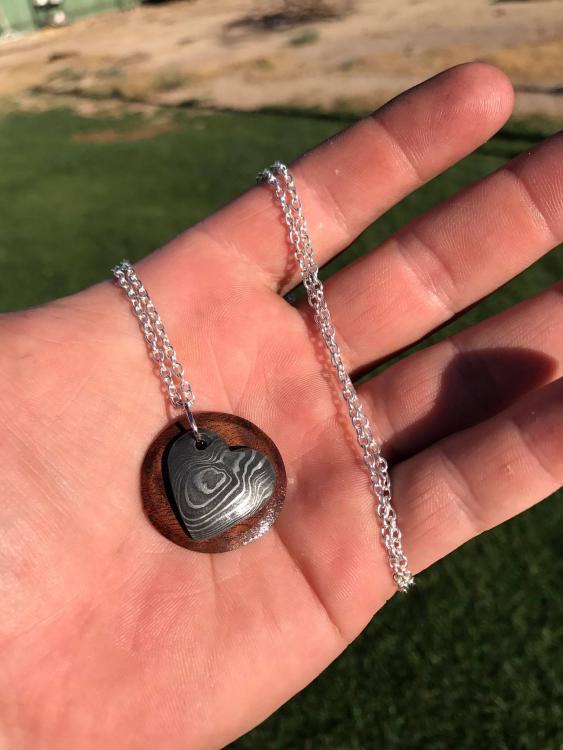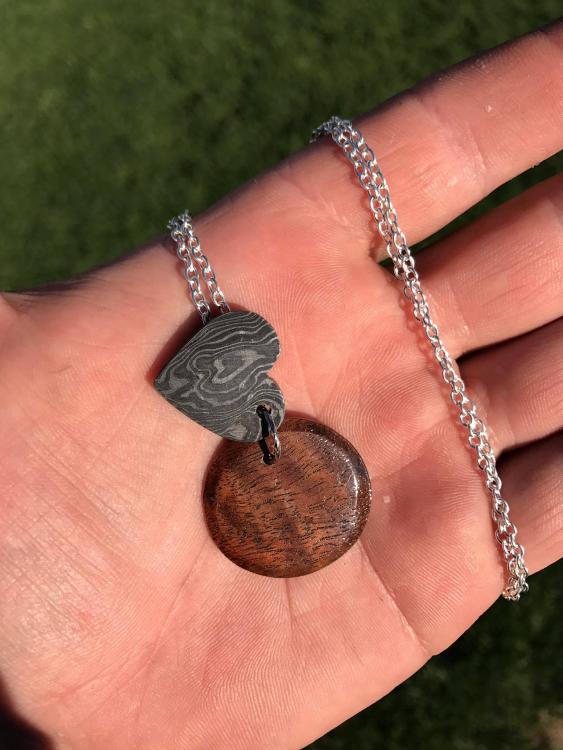-
Posts
312 -
Joined
-
Last visited
Content Type
Profiles
Forums
Articles
Gallery
Downloads
Events
Posts posted by Jclonts82
-
-
I made my first billet of damascus a month or so ago, made my piece, had a little left over. Not being one to throw anything potentially useful away, I made something with it.
From the leftover piece about the size of my pinkey finger, made a mothers-day necklace for the wife. (It can earn you some mega bonus points)
-
I made the Damascus, 7 layers of 1095 and 15n20, hot-cut/folded 4 times by hand.
I didn't want to try a blade with my first attempt of forge welded steel, so made something artistic, where any inclusions/bad welds that might be there wouldn't matter for structural integrity... Good mothers day gift I'm thinking, she loves the Fleur de lis pattern so this is my work in progress.
-
-
10 minutes ago, Kozzy said:
... taking a cleaned sample down to your local big scrap metal buyer. They can use their portable XRF gun to tell you what's actually in the metal and from there you can usually determine the actual grade...
That is an excellent idea. I live in a pretty small town, but there is one recycling center here and I am good friends with the gal that runs it, I will stop by and ask her if she has any ideas or any of the sampling equipment, or even a metallurgy lab she might use. Thank you for the idea.
Now I just need to find the time to investigate...
-
In my first foolings around with it, I clamped it in a vice outside and hit it with a 7" angle grinder to flatten out the 'teeth' to not have any inclusions and decided to hit the whole spindle to de-chrome it, acid etching it off might be easier though.
I will play some more and put up some pics of sparks with known steel comparisons, mild, 15n20, 1095, random stainless... See where I can go from there. I really want to know the steel's composition though, just to know what I'm really working with. It might save headaches and lots of trial and error.
-
I grew up on a farm, pharmacist by current profession, and very recently got started into black/bladesmithing.
We have these used cotton picker spindles in the area, TONS of them.
I am wondering if anyone has messed around with turning them into usable steel. I know they are very tough, and the teeth usually last 2-3 seasons of picking, so I imagine the steel is quite hardenable. I Also know they are chrome plated 50-90 microns (yikes, hexavalent chrome) so I at least stay upwind at all times when messing around with them, or wear proper respirator (overkill?).
Anyways, anybody know what the underlying steel's composition is. I dont have enough experience yet to do an educated spark test, but I do know It shines up to a mirror finish with 400-800 grit sand paper. I emailed the manufacturer and got a response akin to "its our secret"... I'm thinking it might be a chrome-moly steel? Anyways, if anyone knows anything about it, I would sure appreciate any sharing of knowledge. It could be a really cheap source of steel if its worthwhile... maybe even sandwitch with 1080/1095 for some patterns if it will weld?




leftover damascus chunks
in Member Projects
Posted
Thank you all.
It (suprisingly to me) wasn't all that difficult either... I honestly think I spent more time getting the wood behind it down to the thickness of a quarter and a small, even, bevel on it than shaping out the heart.. LOL